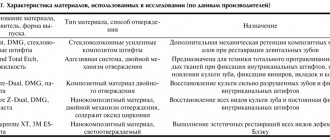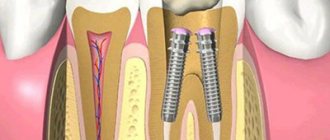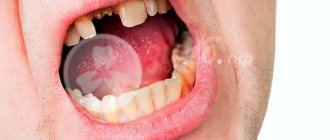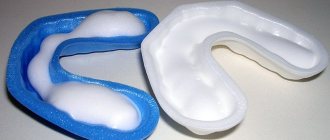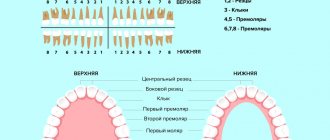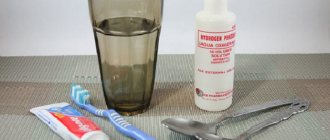What are parapulp pins - features of the pins
The design is a pin of small thickness, which serves as a connecting element between dental tissues and restoration material. Pins are used for fixation in dentin, that is, in the area between the pulp chamber and the periodontium. Approximately half of its length should be in the dentin, while the second half will be located in the thickness of the filling material.
The width of such pins varies from 0.3 to 1 mm, and their length usually does not exceed 5 mm. The number of fixed rods directly depends on the location of the tooth, its anatomical features and the extent of destruction. To restore the anterior incisors, a pin from each corner of the crown is usually sufficient. When restoring chewing molars, most often a pin has to be placed in place of each missing cusp.
Pins are installed in dentin
Parapulpal pins can be fixed in various ways. There are 4 installation options:
- screw: fastening is achieved by screwing the product into dentin,
- frictional: the rods are fixed due to a very tight fit, when the diameter of the pin can be slightly larger than the width of the hole,
- cement: the structure is supported by a special adhesive composition,
- combined: there can be a combination, for example, of friction and cement methods of fastening.
The pins are implanted not into the tooth cavity, but into the dentin - this is their distinctive feature. They provide additional support for the filling material and are a reliable link between the tooth tissue and the composite.
Everything you wanted to know about dental pins in dentistry
The use of dental pins in Kirov dentistry is a very common phenomenon, since it is this technology that allows you to save a tooth in a number of cases. If the treatment involves depulpation (removal of the dental nerve), a pin must be placed in place of the cleaned canals - we dedicated our new article to these devices. From this material you will learn what a pin is, what types there are, how they are installed, and what are the advantages/disadvantages of the decision to use a similar approach in dentistry.
What is a pin?
A dental pin is a specialized structure that is installed in the internal cavity of the tooth root after removal of the nerve. This approach allows you to preserve the root itself and, as a result, the original structure of the jaw, which is very important for every patient.
It is also worth understanding that using a pin to save a tooth is a much more affordable option from a financial point of view when compared with prosthetics.
As a rule, a pinned tooth after treatment requires the installation of a crown (or bridge), and the very possibility of using pins is limited by a number of requirements:
- The thickness of the root walls must be at least 2 millimeters;
- The depth of unsealing the canal is at least 2/3 of its length;
- Possibility of complete (and high-quality obturation of the canal);
- Availability of conditions for giving a conical or cylindrical shape to the channel.
To put it in very simple terms, pins in dentistry are a kind of reinforcing reinforcement when restoring the shape of a tooth after removing nerves and cleaning the canals.
How are pins used in dentistry?
Today, there are five key areas for the use of pins in dentistry in Kirov. Let's consider and comment on each option:
Extension of the crown part of teeth on a pin is a key direction in the implementation of the technology;- Prosthetics with pins in cases where it is not possible to attach the prosthesis to adjacent teeth;
- Reinforcement of a tooth with a removed nerve using a pin insert;
- Treatment of periodontal diseases using combined structures for splinting teeth;
- Carrying out operations to replant your own teeth, where dental pins have also found their use.
Modern dentistry today is simply impossible to imagine without the use of pins.
This is the same indispensable tool for a dentist as, for example, a burr or filling material. Of course, in 8 cases out of 10, these pin structures are used to build up the crown of a tooth, however, many other procedures are also impossible without the use of such products.
Types of pins for teeth
There are several options for making pins for solving dental problems today – let’s look at the most popular and common ones:
- Anchor pins, which can be active or passive, depending on the fixation method. Active ones are screwed into the root of the tooth, which can cause complications. Passive pins are installed in a simple way and are used for reinforcement after tooth depulpation;
- Fiberglass pins. This modern material has a number of important advantages, including elasticity, hypoallergenic properties, ease of installation (in just one visit to the dentist) and the ability to quickly remove in case of dental retreatment;
Carbon fiber pins. In its texture, this material is as close as possible to the natural dentin layer - this is a guarantee of increased strength and reliability;- Parapulpal pins. They are a metal base with a polymer coating;
- Stump tab. It is used in case of serious damage to the crown, since this design is a microprosthesis. Production is carried out individually according to casts.
Pins, like filling compounds, are made from a wide variety of materials: each has its own characteristics and cost, as well as indications. That is why the choice depends on the recommendations of the dentist, who will select the best option based on the characteristics of the disease.
Installation of a pin in Kirov
The pin installation process depends on the type of structure and material used. However, as a rule, the universal treatment algorithm looks like this:
- Inspection and identification of the possibility of using pins for tooth treatment. Typically, this may require an x-ray or even a CT scan;
- Unsealing the canal (if there is a filling) or removing the nerve (in case of a depulpation procedure);
- The pin is installed in the channel, and its excess is cut off (in the case of using carbon or glass fiber);
- Fixation of the pin in the canal using composite compounds;
- Restoration of the crown part of the tooth, which, as a rule, occurs during a second visit to the dentist. The reason is the need for complete hardening of the composite in the channels.
After completion of treatment, such a tooth is closely monitored, analyzing possible pain and other complications.
If there is a feeling of discomfort or pain, especially after removal of the nerve, there is no need to worry, as this is a completely natural phenomenon. After a few days, the pain should subside, otherwise it is better to consult a doctor.
Disadvantages and contraindications
And this article should be completed by familiarizing yourself with the list of disadvantages and contraindications of using pinning technology. Among the negative points are:
- There is a risk of complications if the dentist makes mistakes;
- There is a possibility of allergic reactions;
- Limited service life of a “dead” tooth with pins.
As for contraindications, the key reason for the impossibility of implementing the technology may be the condition of the root walls (insufficient thickness, severe destruction, obstruction of canals, etc.).
In any case, the decision on the possibility of using dental pins is made by the dentist at the initial appointment.
Sign up for a consultation at Dr. Efremov’s Dentistry and get answers to all your questions! Information by phone: 8 (8332) 255-717 . Be healthy and take care of the beauty of your smile!
What elements can be identified in the design?
Tooth restoration using parapulp pins involves working with four main components. Let's look at each in more detail:
- drill – to install pins, use special drills made of carbon steel. They are used to process dentin tissue, while diamond drills are used to process enamel. The tool has two cutting edges, as well as a immersion limiter to a depth of no more than 2-3 mm,
- pin - the product can be made of stainless steel, an alloy of titanium and gold. However, some such systems, when in contact with intradental fluid, cause the development of corrosion,
- dentin – the thickness of the layer varies from 2 to 6 mm, while the dentin tissue is quite elastic and successfully adapts to the implanted structure. However, intense chewing loads can lead to the formation of microcracks in the dentin in the area of contact with the pin. The risk of defects is reduced when installing products into a living tooth with pulp. For the restoration of pulpless elements, intracanal pins are usually used,
- filling - the rod remains approximately 2-3 mm of its length in the thickness of the composite material from which the filling is formed, designed to replenish the destroyed tooth tissue.
The decision to use pins as part of restoration work rests with the attending physician. Only a specialist will be able to correctly assess the clinical picture and suggest the best way to restore the destroyed element.
Advantages and disadvantages of restoring the integrity of the dentition using pins
The main advantage of using parapulp pins is the ability to restore a tooth even in case of severe destruction. There is no need to remove the chewing element and install an implant, since the base will not be affected. This method also has the following advantages:
- the root system is not affected;
- the mucous membranes of the mouth are not irritated (unlike wearing crowns);
- do not cause allergic reactions;
- long period of operation (up to 10 years);
- the ability to choose a pin for a specific situation thanks to a wide range of models;
- affordable price.
Quality, durability and reasonable cost are, of course, huge advantages. But despite all the advantages, modern patients prefer other methods of jaw restoration. The fact is that the metal spoke “shines through” the composite and somewhat spoils the aesthetics. Therefore, it is not recommended to use parapulp pins on incisors and canines without the use of crowns. A good dental specialist will definitely offer a solution to the problem of dentition restoration if the installation of a pin is not suitable for the patient for any reason.
Sources:
- Personal experience as an orthopedic dentist;
- Abolmasov N.G., Abolmasov N.N., Bychkov V.A., Shashmurina V.R. Replacement of defects in teeth and dentition with fixed dentures. - Smolensk, 1995;
- Arutyunov S.D. Principles of designing stump pin inlays for pathological abrasion of teeth. - Dentistry, 3, 1997;
- Bragin E.A., Dolgalev A.A., Skryl A.V. Method of manufacturing stump inlays in a laboratory using fire-resistant models (certificate of rational approval No. 953, issued by SGMA on September 30, 1998);
- Bragin E.A., Cheprakov V.V., Skryl A.V., Stroganov G.N. A method for restoring teeth destroyed below the level of the gingival margin using laser coagulation of the gums (certificate for rationalization No. 963, issued by the SGMA on December 30, 1998);
- Borovsky E.V. Clinical endodontics. — 2nd ed., add. And correct. / E.V. Borovsky. - M.: JSC "Dentistry", 2003;
- Cohen Stephen. Endodontics. — “Peace and Family”, St. Petersburg, 2000;
- N. Baba - Contemporary Restoration of Endodontically Treated Teeth (2016);
- Peter Murray - A Concise Guide to Endodontic Procedures (2015).
Indications for installation
Pins are used for the restoration of teeth with damage of varying degrees of complexity. Such pins can be used both to eliminate a chip and in case of almost complete absence of a crown. Experts in the field of dentistry highlight the following indications in this regard:
- carious destruction, in which severe damage to the enamel and cavity is observed,
- trauma or destruction of the front teeth,
- the need for restoration of chewing molars,
- creation of supports for fixation of removable and fixed dentures,
- restoration of the integrity of the crown in the presence of living pulp.
Such pins are used for restoration of anterior teeth.
“I had 2 molars restored on pins, about 3-4 years ago. The teeth are still in excellent condition, no chips or other problems. I remember that a couple of weeks after installation the sensations were unusual, it was not very convenient to get used to, but maybe it’s just like that for me...”
Timur1, from correspondence on the forum www.32top.ru
The main condition allowing the installation of parapulpal pins is a sufficient layer of dentin between the gum and the root. If this area is too thin, the structures will not be able to be securely fixed. In such a situation, you will have to turn to alternative restoration options.
Options for installing a parapulpal pin
The high level of technological development has made it possible to find several ways to efficiently install such a mechanism in a tooth. The choice of method is determined by the degree of damage to the tooth, the physiological characteristics of the patient’s body, and his tolerance to a particular material. Today there are 3 most popular ways to install such a pin:
- Tooth restoration using glass ionomer cement (GIC)
- Filling with composites that harden when using a light beam
- Tooth repair using a double-rejection filling due to chemical exposure; screwing in the pin with a drill
An experienced dentist, when analyzing the condition of a tooth, will definitely take an x-ray of the tooth, which shows the full picture and allows the specialist to make a decision on installing a particular pin. In some cases, it is possible to install several such rods, which is often necessary in the case of complex restoration of anterior and chewing teeth. If you need high-quality dental fillings, you should only contact a trusted clinic, whose specialists will be able to provide a guarantee for the dental work performed.
Unlike an implant, which is implanted into the bone, a parapulp pin is fixed inside the tooth itself, penetrating into the root system. Today, the cost of such a prosthetic operation is quite acceptable, thanks to which many people with injuries or deep caries can reliably solve their problem. There are practically no contraindications to the installation of such rods, so patients do not have to worry about the risk of rejection of this material. Of all metal alloys, titanium is the most biocompatible, and therefore a person can have absolutely no doubt about reliable fastening, as well as safety for his health.
In what cases is installation contraindicated?
In addition to the fact that a sufficient thickness of the dentin tissue layer is required for smooth pin installation, working with such systems also places some demands on the clinical picture. So, for example, a contraindication to fixing such pins is the complete absence of the coronal part. It will also not be possible to fix the products if the height of the planned crown exceeds the length of the roots, and the root walls are of insufficient thickness - less than 0.2 mm.
Also, certain restrictions on restoration are imposed by blood diseases, psychoneurological disorders, serious damage to periodontal tissue, the presence of cysts and granulomas, and large areas affected by caries.
How does the fixation procedure go - the main stages
The technique for placing a parapulp pin does not involve any complex manipulations or the use of advanced technologies. This is a standard dental procedure, the steps of which are performed in a specific sequence.
Preparing the channel for the structure
After preparing the working area, isolating it from saliva and treating the tissue with an antiseptic, a hole is made in the dentin. In this case, the distance between the wall of the hole and the border of dentin and enamel should be at least 0.5 mm. Using a wide bur, the area is processed, after which a hole for the pin is made with a small bur. The main danger at this stage is damage to the pulp or periodontal tissue. An experienced doctor will not allow this situation to happen by accurately determining the appropriate location for installing the structure.
Inserting a pin into a tooth
Insertion of the pin can be done carefully by hand or using a bur. First you need to install the structure in a special clamp - an angular type clamp is usually used to restore chewing teeth. The optimal depth for pins that are set on cement is considered to be 3 mm, for structures with screw fixation - 1.5-2 mm1. Some systems have a support platform approximately in the middle - it helps to correctly distribute the load on the entire tooth, and therefore extend the service life of the restoration.
PIN insertion can be done carefully
Final crown restoration
Next, the specialist begins layer-by-layer application of the filling material. After completing the formation of the anatomical shape, the restored area is ground and polished. High-quality installed pins increase the reliability of the entire structure - such a filling can last 7-10 years, of course, with proper care and respect for the teeth.
Advantages and disadvantages of pin structures
The most important advantages of restoring damaged teeth using pins are:
- rapid restoration of the functionality of the masticatory apparatus;
- the ability to avoid surgery aimed at extracting a damaged tooth;
- reducing the risk of fracture of the roots of affected teeth when restoring their crown parts with fiberglass pin structures;
- the ability to achieve impeccable aesthetic results;
- high service life of pins (more than 10 years).
At the same time, the method also has several significant drawbacks. In particular, the negative features of dental restorations using post structures are:
- increased degree of development of an allergic reaction to the materials from which the pins are made;
- there is a risk of rejection of the pin device;
- constant thinning of the walls of the restored tooth;
- high probability of developing other complications of the procedure.
What complications can there be?
Restoration using parapulp pins is a standard procedure in dentistry, and the technique of placing pins has long been worked out by specialists down to the smallest nuances. However, in rare cases, mistakes on the part of the doctor can lead to unpleasant consequences - let’s look at them in more detail:
- Damage to periodontal tissue – periodontal perforation usually leads to an aesthetic problem in which the root area turns red and sag, exposing the neck of the tooth. The defect can be corrected by filling the canal with phosphate cement or amalgam. Another option: insert a pin into the canal at the level of the hole and seal it again,
- breakage of the rod or drill - such a nuisance can happen when bending the drill or the pin itself. To avoid such a problem, the instrument and rod must be inserted into the canal and removed as carefully as possible, without sudden rotational movements,
- difficulties when working with a drill - the tool may be dull or the specialist may choose the wrong direction of movement. Another option is that the drill rests on the enamel, which also creates difficulties with sawing fabrics,
- excessive channel width that does not correspond to the diameter of the structure - to solve this problem, you can resort to using a cementing composition.
To assess the quality of the work done, after about 6 months it is worth taking an x-ray and showing it to the doctor. The specialist will assess the condition of the restored element under operating conditions and will be able to promptly notice signs of complications, if any.
General requirements for installing pins
To summarize all of the above, it’s worth formulating the basic requirements for installing pins. Key points are listed below:
- the pin is inserted into the dentin,
- the wall of the hole for the pin should be no closer than 0.5 mm from the border of enamel and dentin, and 1-1.5 mm from the edge of the tooth,
- installation should be carried out taking into account the curvature of the roots and the location of the longitudinal furrows,
- Drilling a canal in dentin should begin with the smallest bur,
- The depth of placement of the rod should not exceed 2 mm for models with screw fixation and 3 mm when seated on cement.
The number of rods directly depends on the location of the tooth.
The number of rods directly depends on the location of the tooth and its role in distributing the chewing load throughout the jaw. For a front cutter, 2-3 additional supports are usually sufficient. As part of the restoration of the masticatory element, up to 4 parapulpal pins may be needed.
Review of popular systems
Today, several different types of pins are used in dentistry. Below in the review are the most popular systems from brands that have established themselves as manufacturers of high-quality, safe and reliable parapulpal pins.
"Stabilok-pin" from Fairfax Dental
The US manufacturer markets titanium structures and pins made of stainless steel. The company's product range includes 2 variations in different diameters - 0.76 and 0.6 mm. The kit also includes drills of appropriate parameters. A special feature of the system is the ability to use an angled tip, which helps the doctor to make the placement as accurately as possible, without the risk of damaging the walls of the formed canal.
Fihol Dental system "Philpin"
The products of the Irish company Fihol Dental are titanium pins designed for installation in the tooth stump. The kit includes a special bending tool that helps bend the structure in the desired direction and direct its top correctly in relation to the stump.
Restaurant pin system RT from Martteler
The Marteler company produces pins in diameters of 0.6 and 0.75 mm. The products are made of titanium or medical steel, reminiscent of the Stabilok-pin, but in this case the pins are bent manually. The kit also includes a special adapter for the drill.
Parapost by Coltene/Whaledent
The Coltene/Whaledent concern offers its model of a parapulp pin, the design of which is also similar to the Stabilok system. However, here one holder combines 2 pins at once. Each of the products has a small protrusion in the middle - a small detail that ensures a more correct distribution of the load on living tissues.
PCP system then Komet
One of the disadvantages of pins is the risk of them showing through the seal. To disguise such a defect, various coatings are used, including gilding. A special feature of Komet systems is the presence of a plastic coating, which certainly will not be visible through the restoration material. In addition, the filling part of the structure has a special shape to hold the amalgam, which is a definite advantage when restoring chewing molars.
Indications for use of this pin
Most often, the main recommendation of dentists for this procedure is severe destruction of the crown part, deep removal of the pulp, and partial destruction of the tooth. Special parapulp pins (pins) are rod structures made of titanium, stainless steel or other alloy, designed for reliable fixation of the filling and its high-quality reinforcement. Such products are installed parallel to the axis of the tooth, being fixed in the deep tissues of the tooth, and in some cases, even in the osseous-facial part. Thanks to this technology, the composite is reliably fixed in the right place on the tooth, thereby ensuring high reliability and guaranteeing resistance to all types of influences.
How much do parapulp pins cost?
The cost of installing parapulp pins includes the price of the products and the work of a specialist. So, one set with 12 pins and a tool for fixing them will cost approximately 1000 rubles. The average cost for installing rods as part of the restoration of one tooth is the same. To calculate the full cost of treatment, you will have to add other costs to this amount: consultation, x-ray examination, tooth preparation, use of anesthesia and antiseptics, filling material.



